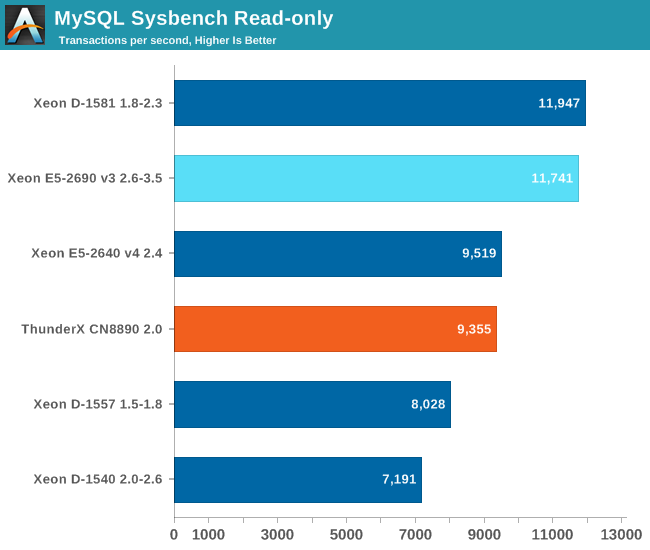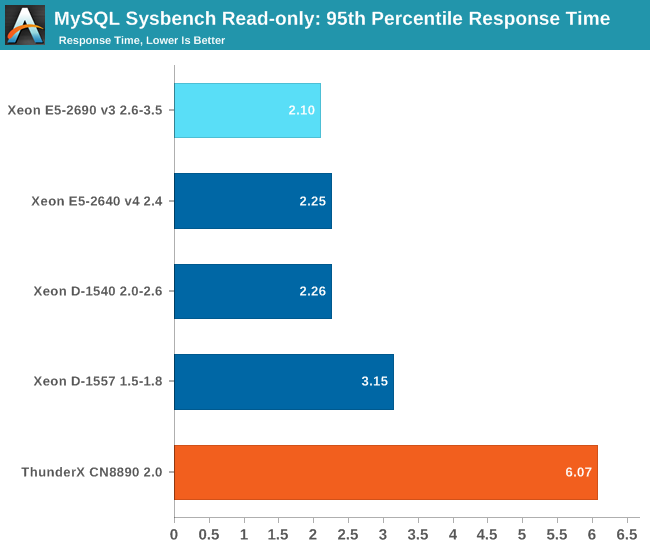Investigating Cavium's ThunderX: The First ARM Server SoC With Ambition
by Johan De Gelas on June 15, 2016 8:00 AM EST- Posted in
- SoCs
- IT Computing
- Enterprise
- Enterprise CPUs
- Microserver
- Cavium
MySQL 5.6.0
Last time we made a small error in our script, causing the Sysbench test to write to our SSDs anyway. That did not make the test invalid, but as we really want to isolate the CPU performance. However due to these changes, you cannot compare this with any similar Sysbench based benchmarking we have done before.
The Intel servers were running Percona Server 5.6 (the best-optimized MySQL server for x86), the ThunderX system was running a special ThunderX optimized version of MySQL 5.6. We used sysbench 0.5 (instead of 0.4) and we implemented the (lua) scripts that allow us to use multiple tables (8 in our case) instead of the default one. According to Cavium, there is still a lot headroom to improve MySQL performance. A ThunderX optimized version of Percona Server 5.7 should improved performance quite a bit.
For our testing we used the read-only OLTP benchmark, which is slightly less realistic, but a good first indication for MySQL Select performance.

A single ThunderX core is capable of 270 transactions/s and scales well: with 32 threads and one thread per core we still get about 8000 tr/s (or 250 tr/s/core). But beyond that point, scaling is much more worse: add another 16 cores and we only get 17% more performance.

But when we look at the response times, things look a lot less rosy. The ThunderX is a lot slower when handling the more heavy SQL statements.
It is clear that the ThunderX is no match for high frequency trading and other database intensive applications. However, when MySQL serves as just a backend for a website and satisfies simple "get data x or y" requests, the 4 extra ms are a small nuisance.










82 Comments
View All Comments
silverblue - Thursday, June 16, 2016 - link
I'm not sure how this is relevant. Johan doesn't review graphics cards, other people at Anandtech do. I bet Guru3D has a much bigger team for that, and I imagine that they have a much narrower scope (i.e. no server stuff).I don't think I've looked at a review recently that hasn't had the comments section polluted with "where is the review for x".
UrQuan3 - Wednesday, June 15, 2016 - link
Intel allows their Xeons to sometimes pull double their TDP? No wonder our new machines trip breakers long before I thought they would. I need to test instead of assuming accurate documentation.I can see why you chose C-Ray, I'm just sorry a more general ray tracer was not chosen. Still, not it's intended market, though I am suddenly very interested. Ray-tracing and video encoding are my top two tasks.
Meteor2 - Thursday, June 16, 2016 - link
The 'T' in 'TDP' is for thermal. It's a measure of the maximum waste heat which needs to be removed over a certain period of time.UrQuan3 - Wednesday, June 22, 2016 - link
Yes, it stands for thermal, but power doesn't consumed doesn't just disappear. Convert it to light, convert it to motion, convert it to heat, etc. In this case there is a small amount of motion (electrons) and the rest has to be heat. I expect much higher instantaneous pulls, but this was sustained power. Anyway, I will track down the AVX documentation mentioned below.I saw the h264ref. I'll be curious about x264 (handbrake) as the authors seem interested in ARM in the last few years. Unsurprisingly, it is far less optimized than x64. I benchmarked handbrake on the Pi2, Pandaboard, and CI-20 last year, just to see what it would do.
JohanAnandtech - Thursday, June 16, 2016 - link
C-Ray was just a place holder to measure FPU energy consumption. I look into bringing a more potent raytracer into our benchmark suite (povray)Video encoding was in the review though, somewhat (h264ref).
patrickjp93 - Friday, June 17, 2016 - link
ARM chips with vector extensions allow it as well. Intel provides separate documentation for AVX-workload TDPs.Antony Newman - Wednesday, June 15, 2016 - link
Fascinating article.Why would Cavium not try and use 54 x A73s in their next chip?
If ARM are not in the business of making Silicon, and ARM think the '1.2W Ares' will help them break into the Server market ... Then Why do we think ARM isn't working with the likes of Cavium to get a Server SoC that rocks the Intel boat?
Typos From memory : send -> sent. Through-> thought. There were a few others.
AJ
name99 - Thursday, June 16, 2016 - link
How do you know ARM aren't working with such a vendor?ARM has always said that they expect ARM server CPUs to only be marginally competitive (for very limited situations) in 2017, and to only be really competitive in 2020.
That suggests, among other things, that if they are working with partners, they have a target launch between those two dates, and they regard all launches before 2017 as essentially nice for PR and fr building up the ecosystem, but essentially irrelevant for commercial purposes.
rahvin - Thursday, June 16, 2016 - link
The problem as pointed out early in this article is that ARM keeps targeting Intel's current products, not the ones that will be out when they get their products out. We've had almost a dozen vendors get to the point of releasing the chip and drop it because it is simply not competitive with Intel. Most of these arm products were under taken when Intel was targeting performance without regard to performance/watt. Now that intel targets the later metric arm server chips haven't been competitive with them.Fact is Intel could decimate and totally take over all the markets arm chips occupy, but to do it they'd have to cannibalize their existing high profit sales. This is why they keep canceling Atom chips, the chips turned out so good they were worried they'd cannibalize much more expensive products. This is the reason Avoton is highly restricted in what products and price segments it's allowed into. If Intel opened the flood gates on Avoton they would risk cannibalizing their own server profits.
junky77 - Wednesday, June 15, 2016 - link
So, they did what AMD couldn't for years? I'm trying to figure it out.. their offering seems to be a lot more interesting than AMD's stuff currently